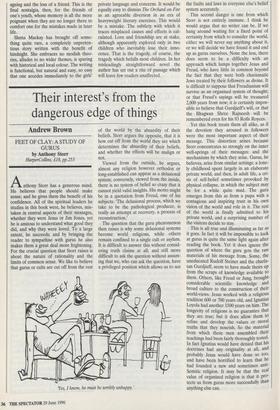Their interest's from the dangerous edge of things
Andrew Brown
FEET OF CLAY: A STUDY OF GURUS by Anthony Storr HarperCollins, f18, pp.253 Anthony Storr has a generous mind. He believes that people should make sense; and he gives them the benefit of his confidence. All of the spiritual leaders he studies in this book were, he believes, mis- taken in central aspects of their messages, whether they were Jesus or Jim Jones, yet he is anxious to understand what good they did, and why they were loved. To a large extent, he succeeds; and by bringing the reader to sympathise with gurus he also makes them a great deal more frightening. For the crucial question that Storr raises is about the nature of rationality and the limits of common sense. We like to believe that gurus or cults are cut off from the rest
of the world by the absurdity of their beliefs. Storr argues the opposite, that it is how cut off from the world they are which determines the absurdity of their beliefs, and whether the effects will be malign or not.
Viewed from the outside, he argues, almost any religion however orthodox or long-established can appear as a delusional system; conversely, viewed from the inside, there is no system of belief so crazy that it cannot yield valid insights. His motto might be in a quotation from Freud, one of his subjects: 'The delusional process, which we take to be the pathological producer, is really an attempt at recovery, a process of reconstruction.'
The question that the guru phenomenon then raises is why some delusional systems become world religions, while others remain confined to a single cult or asylum. It is difficult to answer this without consid- ering truth claims at all; and still more difficult to ask the question without assum- ing that we, who can ask the question, have a privileged position which allows us to see Tes, I know, he must be terribly unhappy.' the faults and laws in everyone else's belief system accurately.
This second danger is one from which Storr is not entirely immune. I think he would argue that no writer can be. If we hang around waiting for a fixed point of certainty from which to consider the world, either we will never say anything about it, or we will decide we have found it and end up as gurus ourselves. None the less, there does seem to be a difficulty with an approach which lumps together Jesus and Freud, who have little in common beyond the fact that they were both charismatic Jews treated by their followers as divine. It is difficult to suppose that Freudianism will survive as an organised system of thought; or that Freud's sayings will be treasured 2,000 years from now; it is certainly impos- sible to believe that Gurdjieffs will, or that the Bhagwan Shree Rajneesh will be remembered even for his 93 Rolls Royces.
Yet this book treats them all alike, as if the devotion they aroused in followers were the most important aspect of their message. This distortion arises because Storr concentrates so strongly on the inner well-springs of their messages: and the mechanisms by which they arise. Gurus, he believes, arise from similar settings: a lone- ly childhood spent largely in an elaborate private world, and then, in adult life, a cri- sis of self-belief sometimes provoked by physical collapse, in which the subject may be for a while quite mad. The guru emerges from this as from a pupa with a contagious and inspiring trust in his own vision of the world and role in it. The rest of the world is finally admitted to his private world, and a surprising number of the visitors decide to stay.
This is all true and illuminating as far as it goes. In fact it will be impossible to look at gurus in quite the same light again after reading the book. Yet it does ignore the question of where the guru gets the raw materials of his message from. Some, the uneducated Rudolf Steiner and the charla- tan Gurdjieff, seem to have made theirs up from the scraps of knowledge available to them. Others, like Freud or Jung, brought' considerable scientific knowledge and broad culture to the construction of their world-views. Jesus worked with a religious tradition 600 or 700 years old, and Ignatius Loyola had another 1500 years on him. The longevity of religions is no guarantee that they are true; but it does allow them to refine and develop the values or moral truths that they nourish. So the material from which these men assembled their teachings had been fairly thoroughly tested. In fact Ignatius would have denied that his doctrines had any originality at all, and probably Jesus would have done so too, and have been horrified to learn that he had founded a new and sometimes anti- Semitic religion. It may be that the real value of organised religion is that it pro- tects us from gurus more successfully than anything else can.


























































 Previous page
Previous page